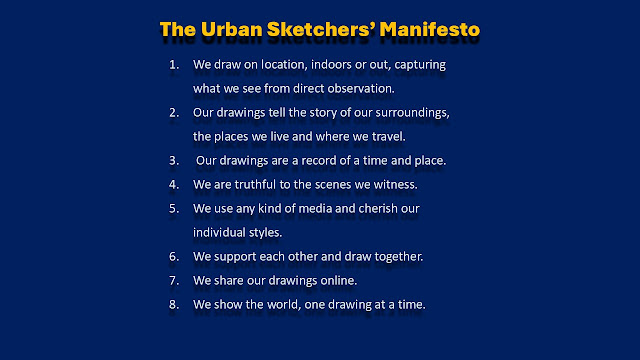Urban Sketchers Manifesto
What is Urban Sketchers Manifesto?
The Urban Sketchers’ Manifesto
1
Excerpt from The Art of Urban Sketching, book written by Gabriel Campanario
1 Gabriel Campanario, The Art of Urban Sketching-Drawing on location around the world : First Published
in 2012 by Quarry Books, an imprint of The Quarto Group.
1. We draw on location, indoors or outdoors, capturing what we see from direct observation.
Urban sketching is a raw and pure form of art that requires drawing from life, rather than from photographs or the imagination. In most cases, urban sketching is practiced on the street. Some sketchers lean up against a tree or the corner of a building or sit on a stair or bench. Others bring along a folding stool. In daylight or at night, whether it’s hot or cold, in rain or sunshine, urban sketchers draw what they witness.
2. Our drawings tell the story of our surroundings, the places we live and where we travel.
Sketching the urban environment produces more than a hand-drawn representation of a given place. Behind each drawing is a story of what was happening before our eyes: a building being torn down, a business closing its doors, or an encounter with a stranger in the subway. Sketches become first-person accounts of life as it happens.
3. Our drawings are a record of a time and place.
In the same way a diarist dates a journal entry, urban sketchers often date their drawing, sometimes going as far as to write down the exact hour and minute at which they were completed. It’s a way to prove that we’ve “been there, drawn that.”
A sketch captures a moment, a unique experience that can’t be repeated. And because we took the time to create it, instead of snapping a photo in an instant, the sketch has the power to bring back much sharper memories.
4. We are truthful to the scenes we witness.
Artists who practice urban sketching interpret the reality before them through their own points of view. Being truthful doesn’t mean drawing every window in a building or keeping lines straight. Each artist is free to infuse each sketch with his or her personality, while keeping the essence of what he or she sees. Some sketchers like detailed work, spending hours in front of their subjects; others synthesize the essence of a streetscape in a few simple strokes.
5. We use any kind of media and cherish our individual styles.
Pencils, pens, fountain pens, markers, colored pencils, crayons: the media urban sketchers use are endless, as are the possibilities, when you combine them to draw on any kind of paper, whether bound in sketchbooks or in single sheets. But the media doesn’t define the art. All that urban sketching requires is making marks on paper to draw what we see.
6. We support each other and draw together.
The internet has helped urban sketchers find each other; as a result, more meet to draw together than ever in the past.
Taking inspiration from pub crawls, in which friends travel from bar to bar, Italian artist Enrico Casarosa started inviting people in San Francisco to meet for a sketchcrawl, a day of communal sketching around the city. World Wide Sketchcrawl days, announced on Casarosa’s SketchCrawl website, have been adopted by urban sketchers as drawing holidays. The term is also commonly used to refer to any kind of group sketching outing.
For people too nervous to draw alone or who want to overcome a fear of drawing in public, getting together with like-minded artists provides a supportive network and endless motivation. After a few hours of drawing, passing around the results from the session over a meal or drink is an extra payoff.
7. We share our drawings online.
If not for the Internet, the global urban sketching community would remain a disconnected group of artists. Using blogs and image-sharing sites, like-minded artists are calling attention to the benefits of sketching on location, opening a window onto the world, and motivating each other to draw.
8. We show the world, one drawing at a time.
The urban sketcher’s quest to draw the world is not limited to city landmarks or historic locations. Any scene, no matter how mundane, is worth drawing. A sketch has the ability to elevate the least picturesque location into something worth looking at and reflecting upon.



.jpg)
Comments
Post a Comment